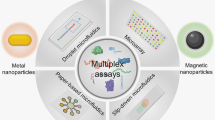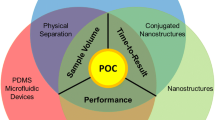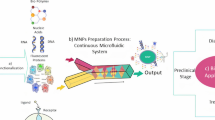Abstract
Nanomaterials have several advantages in detecting several biomaterials and in enhancing signals and their inherent effects. Thus, they have been widely applied in the biomedical fields such as biosensor and cancer therapeutics. Recently, the development of microfluidic technology has led to superior biological analysis systems to detect biomarkers related to diseases or serve as in vitro drug screening platform. In a microfluidic device, samples could be analyzed more accurately, rapidly and simply. In addition, it is possible to culture the cells in these microfluidic devices, therefore making the in situ analysis of secretomes easy. Nanomaterials can be easily applied in the microfluidic channels as capturing and signaling materials in order to improve the sensing or therapeutic property. In particular, nanomaterial integrated microfluidic cell culture model can replace in vivo disease models for nanotherapeutics screening. In this review, nanomaterial-based sensing systems, which include diverse organic and inorganic nanoparticles, are introduced with specific examples, including microfluidics integrated systems. Moreover, microfluidics derived nanomaterial analytic systems as in vitro 2 or 3-dimensional (2D or 3D) cell culture platform will be presented. We also highlight the future perspectives of the microfluidic-driven system as highly sensitive total analysis system with functional nanoparticles.
Similar content being viewed by others
References
You, C.-C. et al. Detection and identification of proteins using nanoparticle-fluorescent polymer ‘chemical nose’ sensors. Nat. Nanotechnol. 2, 318–323 (2007).
Miranda, O.R. et al. Colorimetric bacteria sensing using a supramolecular enzyme-nanoparticle biosensor. J. Am. Chem. Soc. 133, 9650–9653 (2011).
Jain, P.K., Huang, X.H., El-Sayed, I.H. & El-Sayed, M.A. Noble Metals on the Nanoscale: Optical and Photothermal Properties and Some Applications in Imaging, Sensing, Biology, and Medicine. Acc. Chem. Res. 41, 1578–1586 (2008).
Saha, K., Agasti, S.S., Kim, C., Li, X. & Rotello, V.M. Gold nanoparticles in chemical and biological sensing. Chem. Rev. 112, 2739–2779 (2012).
Ghosh, P., Han, G., De, M., Kim, C.K. & Rotello, V.M. Gold nanoparticles in delivery applications. Adv. Drug. Deliv. Rev. 60, 1307–1315 (2008).
Maier, S.A. et al. Plasmonics -a route to nanoscale optical devices. Adv. Mater. 13, 1501–1505 (2001).
Liu, H.L. et al. Magnetic resonance monitoring of focused ultrasound/magnetic nanoparticle targeting delivery of therapeutic agents to the brain. Proc. Natl. Acad. Sci. USA 107, 15205–15210 (2010).
Sperling, R.A. & Parak, W.J. Surface modification, functionalization and bioconjugation of colloidal inorganic nanoparticles. Philos. Trans. A. Math. Phys. Eng. Sci. 368, 1333–1383 (2010).
Crooks, R.M., Zhao, M., Sun, L., Chechik, V. & Yeung, L.K. Dendrimer-encapsulated metal nanoparticles: synthesis, characterization, and applications to catalysis. Acc. Chem. Res. 34, 181–190 (2001).
Choi, J.H. et al. Dye-doped silica nanoparticle with HIV-1 TAT peptide for bioimaging. J. Biomed. Nanotechnol. 9, 291–294 (2013).
Liu, Y.Y., Miyoshi, H. & Nakamura, M. Nanomedicine for drug delivery and imaging: A promising avenue for cancer therapy and diagnosis using targeted functional nanoparticles. Int. J. Cancer 120, 2527–2537 (2007).
Janib, S.M., Moses, A.S. & MacKay, J.A. Imaging and drug delivery using theranostic nanoparticles. Adv. Drug Deliv. Rev. 62, 1052–1063 (2010).
Li, Z.H. et al. Rapid and Sensitive Detection of Protein Biomarker Using a Portable Fluorescence Biosensor Based on Quantum Dots and a Lateral Flow Test Strip. Anal. Chem. 82, 7008–7014 (2010).
Wang, K. et al. A highly sensitive and rapid organophosphate biosensor based on enhancement of CdSdecorated graphene nanocomposite. Anal. Chim. Acta. 695, 84–88 (2011).
Ackerson, C.J., Jadzinsky, P.D., Jensen, G.J. & Kornberg, R.D. Rigid, specific, and discrete gold nanoparticle/ antibody conjugates. J. Am. Chem. Soc. 128, 2635–2640 (2006).
Yan, J.L. et al. Dye-doped nanoparticles for bioanalysis. Nano Today 2, 44–50 (2007).
Kumar, R., Maitra, A.N., Patanjali, P.K. & Sharma, P. Hollow gold nanoparticles encapsulating horseradish peroxidase. Biomaterials 26, 6743–6753 (2005).
Cheng, Z., Al Zaki, A., Hui, J.Z., Muzykantov, V.R. & Tsourkas, A. Multifunctional nanoparticles: cost versus benefit of adding targeting and imaging capabilities. Science 338, 903–910 (2012).
Chen, J., Ji, X., Tinnefeld, P. & He, Z. Multifunctional Dumbbell-Shaped DNA-Templated Selective Formation of Fluorescent Silver Nanoclusters or Copper Nanoparticles for Sensitive Detection of Biomolecules. ACS Appl. Mater. Interfaces 8, 1786–1794 (2016).
Liu, J. et al. Multifunctional aptamer-based nanoparticles for targeted drug delivery to circumvent cancer resistance. Biomaterials 91, 44–56 (2016).
Xu, X., Ho, W., Zhang, X., Bertrand, N. & Farokhzad, O. Cancer nanomedicine: from targeted delivery to combination therapy. Trends Mol. Med. 21, 223–232 (2015).
Kim, C.S. et al. Co-Delivery of Protein and Small Molecule Therapeutics Using Nanoparticle-Stabilized Nanocapsules. Bioconjugate Chem. 26, 950–954 (2015).
Rosalia, R.A. et al. CD40-targeted dendritic cell delivery of PLGA-nanoparticle vaccines induce potent anti-tumor responses. Biomaterials 40, 88–97 (2015).
Gao, H. et al. Precise glioma targeting of and penetration by aptamer and peptide dual-functioned nanoparticles. Biomaterials 33, 5115–5123 (2012).
Bertrand, N., Wu, J., Xu, X., Kamaly, N. & Farokhzad, O.C. Cancer nanotechnology: the impact of passive and active targeting in the era of modern cancer biology. Adv. Drug Deliv. Rev. 66, 2–25 (2014).
Karagiannis, G.S. et al. Cancer-Associated Fibroblasts Drive the Progression of Metastasis through both Paracrine and Mechanical Pressure on Cancer Tissue. Mol. Cancer Res. 10, 1403–1418 (2012).
Xu, S., Olenyuk, B.Z., Okamoto, C.T. & Hamm-Alvarez, S.F. Targeting receptor-mediated endocytotic pathways with nanoparticles: rationale and advances. Adv. Drug Deliv. Rev. 65, 121–138 (2013).
Lee, J.H. et al. On-demand drug release system for in vivo cancer treatment through self-assembled magnetic nanoparticles. Angew. Chem. Int. Ed. 125, 4480–4484 (2013).
Lee, P. et al. Enhancement of anticancer efficacy using modified lipophilic nanoparticle drug encapsulation. Int. J. Nanomedicine 7, 731–737 (2012).
Corrigan, O.I. & Li, X. Quantifying drug release from PLGA nanoparticulates. Eur. J. Pharm. Sci. 37, 477–485 (2009).
Zheng, M. et al. Single-step assembly of DOX/ICG loaded lipid—polymer nanoparticles for highly effective chemo-photothermal combination therapy. ACS Nano 7, 2056–2067 (2013).
Pissuwan, D., Niidome, T. & Cortie, M.B. The forthcoming applications of gold nanoparticles in drug and gene delivery systems. J. Control. Release 149, 65–71 (2011).
Wang, M. & Thanou, M. Targeting nanoparticles to cancer. Pharmacol. Res. 62, 90–99 (2010).
Ulbrich, K., Hekmatara, T., Herbert, E. & Kreuter, J. Transferrin-and transferrin-receptor-antibody-modified nanoparticles enable drug delivery across the bloodbrain barrier (BBB). Eur. J. Pharm. Biopharm. 71, 251–256 (2009).
Peluffo, H. et al. BBB-targeting, protein-based nanomedicines for drug and nucleic acid delivery to the CNS. Biotechnol. Adv. 33, 277–287 (2015).
Valencia, P.M. et al. Microfluidic platform for combinatorial synthesis and optimization of targeted nanoparticles for cancer therapy. ACS Nano 7, 10671–10680 (2013).
Valencia, P.M., Farokhzad, O.C., Karnik, R. & Langer, R. Microfluidic technologies for accelerating the clinical translation of nanoparticles. Nat. Nanotechnol. 7, 623–629 (2012).
Sackmann, E.K., Fulton, A.L. & Beebe, D.J. The present and future role of microfluidics in biomedical research. Nature 507, 181–189 (2014).
Kuo, J.N. & Zhan, Y.H. Microfluidic chip for rapid and automatic extraction of plasma from whole human blood. Microsyst. Technol. 21, 255–261 (2015).
Roy, K., Mao, H.Q., Huang, S.K. & Leong, K.W. Oral gene delivery with chitosan—DNA nanoparticles generates immunologic protection in a murine model of peanut allergy. Nat. Med. 5, 387–391 (1999).
Wong, C. et al. Multistage nanoparticle delivery system for deep penetration into tumor tissue. Proc. Natl. Acad. Sci. USA 108, 2426–2431 (2011).
Arami, H., Khandhar, A., Liggitt, D. & Krishnan, K.M. In vivo delivery, pharmacokinetics, biodistribution and toxicity of iron oxide nanoparticles. Chem. Soc. Rev. 44, 8576–8607 (2015).
Mestas, J. & Hughes, C.C. Of mice and not men: differences between mouse and human immunology. J. Immunol. 172, 2731–2738 (2004).
Huh, D. et al. Reconstituting organ-level lung functions on a chip. Science 328, 1662–1668 (2010).
Li, Y. et al. Cell and nanoparticle transport in tumour microvasculature: the role of size, shape and surface functionality of nanoparticles. Interface Focus 6, 20150086 (2016).
Cao, Q.L., Han, X.T. & Li, L. Numerical analysis of magnetic nanoparticle transport in microfluidic systems under the influence of permanent magnets. J. Phys. D. Appl. Phys. 45, 465001 (2012).
Kwak, B., Ozcelikkale, A., Shin, C.S., Park, K. & Han, B. Simulation of complex transport of nanoparticles around a tumor using tumor-microenvironment-onchip. J. Control. Release 194, 157–167 (2014).
Polavarapu, L., Perez-Juste, J., Xu, Q.H. & Liz-Marzan, L.M. Optical sensing of biological, chemical and ionic species through aggregation of plasmonic nanoparticles. J. Mater. Chem. C 2, 7460–7476 (2014).
Guo, L., Xu, Y., Ferhan, A.R., Chen, G. & Kim, D.H. Oriented gold nanoparticle aggregation for colorimetric sensors with surprisingly high analytical figures of merit. J. Am. Chem. Soc. 135, 12338–12345 (2013).
Thavanathan, J., Huang, N.M. & Thong, K.L. Colorimetric detection of DNA hybridization based on a dual platform of gold nanoparticles and graphene oxide. Biosens. Bioelectron. 55, 91–98 (2014).
Li, Z. et al. Reversible plasmonic circular dichroism of Au nanorod and DNA assemblies. J. Am. Chem. Soc. 134, 3322–3325 (2012).
Ma, X.M. et al. Gold Nanorods as Colorful Chromogenic Substrates for Semiquantitative Detection of Nucleic Acids, Proteins, and Small Molecules with the Naked Eye. Anal. Chem. 88, 3227–3234 (2016).
Dennis, A.M., Rhee, W.J., Sotto, D., Dublin, S.N. & Bao, G. Quantum dot-fluorescent protein FRET probes for sensing intracellular pH. ACS Nano 6, 2917–2924 (2012).
Liu, J., Cheng, J. & Zhang, Y. Upconversion nanoparticle based LRET system for sensitive detection of MRSA DNA sequence. Biosens. Bioelectron. 43, 252–256 (2013).
Choi, J.H. et al. A novel Au-nanoparticle biosensor for the rapid and simple detection of PSA using a sequencespecific peptide cleavage reaction. Biosens. Bioelectron. 49, 415–419 (2013).
Shi, X.H. et al. Enzymatic biosensors based on the use of metal oxide nanoparticles. Microchimica Acta 181, 1–22 (2014).
Espina, V. et al. Protein microarray detection strategies: focus on direct detection technologies. J. Immunol. Methods 290, 121–133 (2004).
Choi, J.H., Lim, Y.T. & Oh, B.K. Development of Colorimetric Enzyme-Ball for Signal Amplification of Enzyme-Linked Immunosorbent Assay. Sci. Adv. Mater. 6, 2572–2576 (2014).
Choi, J.H., Koo, Y.K., Kim, B.R. & Oh, B.K. An Attomolar Detectable Colorimetric DNA Biosensor based on Enzyme Amplification Method. BioChip J. 3, 224–229 (2009).
Kim, H.-S. & Oh, B.-K. A rapid and sensitive immunoassay for detection of E. coli O157: H 7 using multienzyme -Au nanoparticle complex. BioChip J. 8, 1–7 (2014).
Lafleur, J.P., Senkbeil, S., Jensen, T.G. & Kutter, J.P. Gold nanoparticle-based optical microfluidic sensors for analysis of environmental pollutants. Lab Chip 12, 4651–4656 (2012).
Zhang, B. et al. Multiplexed cytokine detection on plasmonic gold substrates with enhanced near-infrared fluorescence. Nano Research 6, 113–120 (2013).
Kuo, S.Y. et al. Dual colorimetric and fluorescent sensor based on semiconducting polymer dots for ratiometric detection of lead ions in living cells. Anal. Chem. 87, 4765–4771 (2015).
Huang, N.T. et al. An integrated microfluidic platform for in situ cellular cytokine secretion immunophenotyping. Lab Chip 12, 4093–4101 (2012).
Homola, J., Yee, S.S. & Gauglitz, G. Surface plasmon resonance sensors: review. Sensor Actuat. B-Chem. 54, 3–15 (1999).
Willets, K.A. & van Duyne, R.P. Localized surface plasmon resonance spectroscopy and sensing. Annu. Rev. Phys. Chem. 58, 267–297 (2007).
Choi, J.H., Lee, J.H., Oh, B.K. & Choi, J.W. Localized surface plasmon resonance-based label-free biosensor for highly sensitive detection of dopamine. J. Nanosci. Nanotechnol. 14, 5658–5661 (2014).
Choi, Y., Choi, J.-H., Liu, L., Oh, B.-K. & Park, S. Optical sensitivity comparison of multiblock gold-silver nanorods toward biomolecule detection: quadrupole surface plasmonic detection of dopamine. Chem. Mater. 25, 919–926 (2013).
Huang, C. et al. Localized surface plasmon resonance biosensor integrated with microfluidic chip. Biomed. Microdevices 11, 893–901 (2009).
Escobedo, C. et al. Quantification of ovarian cancer markers with integrated microfluidic concentration gradient and imaging nanohole surface plasmon resonance. Analyst 138, 1450–1458 (2013).
Oh, B.R. et al. Integrated Nanoplasmonic Sensing for Cellular Functional Immunoanalysis Using Human Blood. ACS Nano 8, 2667–2676 (2014).
Chen, P.Y. et al. Multiplex Serum Cytokine Immunoassay Using Nanoplasmonic Biosensor Microarrays. ACS Nano 9, 4173–4181 (2015).
Stiles, P.L., Dieringer, J.A., Shah, N.C. & van Duyne, R.P. Surface-enhanced Raman spectroscopy. Annu. Rev. Anal. Chem. (Palo Alto Calif) 1, 601–626 (2008).
El-Said, W.A. & Choi, J.W. In-situ detection of neurotransmitter release from PC12 cells using Surface Enhanced Raman Spectroscopy. Biotechnol. Bioprocess Eng. 19, 1069–1076 (2014).
Yin, P.T., Kim, T.H., Choi, J.W. & Lee, K.B. Prospects for graphene-nanoparticle-based hybrid sensors. Phys. Chem. Chem. Phys. 15, 12785–12799 (2013).
Park, T. et al. Highly sensitive signal detection of duplex dye-labelled DNA oligonucleotides in a PDMS microfluidic chip: confocal surface-enhanced Raman spectroscopic study. Lab Chip 5, 437–442 (2005).
Sha, M.Y., Xu, H., Natan, M.J. & Cromer, R. Surfaceenhanced Raman scattering tags for rapid and homogeneous detection of circulating tumor cells in the presence of human whole blood. J. Am. Chem. Soc. 130, 17214–17215 (2008).
Zhang, X.L., Yin, H.B., Cooper, J.M. & Haswell, S.J. Characterization of cellular chemical dynamics using combined microfluidic and Raman techniques. Anal. Bioanal. Chem. 390, 833–840 (2008).
El-Said, W.A., Kim, T.H., Chung, Y.H. & Choi, J.W. Fabrication of new single cell chip to monitor intracellular and extracellular redox state based on spectroelectrochemical method. Biomaterials 40, 80–87 (2015).
Zhai, D. et al. Highly sensitive glucose sensor based on pt nanoparticle/polyaniline hydrogel heterostructures. ACS Nano 7, 3540–3546 (2013).
Wang, L. et al. Highly Sensitive Electrochemical Biosensor for Evaluation of Oxidative Stress Based on the Nanointerface of Graphene Nanocomposites Blended with Gold, Fe3O4, and Platinum Nanoparticles. ACS Appl. Mater. Interfaces 7, 18441–18449 (2015).
Liu, Y., Kwa, T. & Revzin, A. Simultaneous detection of cell-secreted TNF-alpha, and IFN-gamma using micropatterned aptamer-modified electrodes. Biomaterials 33, 7347–7355 (2012).
Mir, M., Homs, A. & Samitier, J. Integrated electrochemical DNA biosensors for lab-on-a-chip devices. Electrophoresis 30, 3386–3397 (2009).
Picher, M.M. et al. Nanobiotechnology advanced antifouling surfaces for the continuous electrochemical monitoring of glucose in whole blood using a lab-on-achip. Lab Chip 13, 1780–1789 (2013).
Ölcer, Z. et al. Microfluidics and nanoparticles based amperometric biosensor for the detection of cyanobacteria (Planktothrix agardhii NIVA-CYA 116)DNA. Biosens. Bioelectron. 70, 426–432 (2015).
Raiteri, R., Grattarola, M., Butt, H.J. & Skladal, P. Micromechanical cantilever-based biosensors. Sensor Actuat. B-Chem. 79, 115–126 (2001).
Xu, T. et al. Real-time enzyme-digesting identification of double-strand DNA in a resonance-cantilever embedded micro-chamber. Lab Chip 14, 1206–1214 (2014).
Zhi, X. et al. A novel HBV genotypes detecting system combined with microfluidic chip, loop-mediated isothermal amplification and GMR sensors. Biosens. Bioelectron. 54, 372–377 (2014).
Lian, J. et al. A fully automated in vitro diagnostic system based on magnetic tunnel junction arrays and superparamagnetic particles. J. Appl. Phys. 111, 07B315 (2012).
Davis, M.E., Chen, Z.G. & Shin, D.M. Nanoparticle therapeutics: an emerging treatment modality for cancer. Nat. Rev. Drug Discov. 7, 771–782 (2008).
Storm, G., Belliot, S.O., Daemen, T. & Lasic, D.D. Surface Modification of Nanoparticles to Oppose Uptake by the Mononuclear Phagocyte System. Adv. Drug Deliv. Rev. 17, 31–48 (1995).
Gupta, A.K. & Wells, S. Surface-modified superparamagnetic nanoparticles for drug delivery: preparation, characterization, and cytotoxicity studies. IEEE Trans. Nanobioscience 3, 66–73 (2004).
Nicolas, J., Mura, S., Brambilla, D., Mackiewicz, N. & Couvreur, P. Design, functionalization strategies and biomedical applications of targeted biodegradable/ biocompatible polymer-based nanocarriers for drug delivery. Chem. Soc. Rev. 42, 1147–1235 (2013).
Liang, R., Wei, M., Evans, D.G. & Duan, X. Inorganic nanomaterials for bioimaging, targeted drug delivery and therapeutics. Chem. Commun. (Camb) 50, 14071–14081 (2014).
Choi, J.H. & Oh, B.K. Development of two-component nanorod complex for dual-fluorescence imaging and siRNA delivery. J. Microbiol. Biotechnol. 24, 1291–1299 (2014).
Choi, J.H. et al. A novel albumin nanocomplex containing both small interfering RNA and gold nanorods for synergetic anticancer therapy. Nanoscale 7, 9229–9237 (2015).
Eifler, A.C. & Thaxton, C.S. Nanoparticle therapeutics: FDA approval, clinical trials, regulatory pathways, and case study. Methods Mol. Biol. 726, 325–338 (2011).
Zhang, H., Lee, M.Y., Hogg, M.G., Dordick, J.S. & Sharfstein, S.T. Gene delivery in three-dimensional cell cultures by superparamagnetic nanoparticles. ACS Nano 4, 4733–4743 (2010).
Chetprayoon, P., Matsusaki, M. & Akashi, M. Threedimensional human arterial wall models for in vitro permeability assessment of drug and nanocarriers. Biochem. Biophys. Res. Commun. 456, 392–397 (2015).
Kusunose, J. et al. Microfluidic system for facilitated quantification of nanoparticle accumulation to cells under laminar flow. Ann. Biomed. Eng. 41, 89–99 (2013).
Samuel, S.P. et al. Multifactorial determinants that govern nanoparticle uptake by human endothelial cells under flow. Int. J. Nanomedicine 7, 2943–2956 (2012).
Kim, Y. et al. Probing nanoparticle translocation across the permeable endothelium in experimental atherosclerosis. Proc. Natl. Acad. Sci. USA 111, 1078–1083 (2014).
Jastrzebska, E. et al. Microfluidic platform for photodynamic therapy cytotoxicity analysis of nanoencapsulated indocyanine-type photosensitizers. Biomicrofluidics 10, 014116 (2016).
Zervantonakis, I.K. & Arvanitis, C.D. Controlled Drug Release and Chemotherapy Response in a Novel Acoustofluidic 3D Tumor Platform. Small 12, 2616–2626 (2016).
Albanese, A., Lam, A.K., Sykes, E.A., Rocheleau, J.V. & Chan, W.C.W. Tumour-on-a-chip provides an optical window into nanoparticle tissue transport. Nat. Comm. 4 (2013).
Bhise, N.S. et al. Organ-on-a-chip platforms for studying drug delivery systems. J. Control Release 190, 82–93 (2014).
Author information
Authors and Affiliations
Corresponding author
Rights and permissions
About this article
Cite this article
Choi, JH., Lee, J. & Oh, BK. Nanomaterial-based in vitro analytical system for diagnosis and therapy in microfluidic device. BioChip J 10, 331–345 (2016). https://doi.org/10.1007/s13206-016-0409-z
Received:
Accepted:
Published:
Issue Date:
DOI: https://doi.org/10.1007/s13206-016-0409-z




